| Pages:
1
..
45
46
47
48
49
..
66 |
elementcollector1
International Hazard
    
Posts: 2684
Registered: 28-12-2011
Location: The Known Universe
Member Is Offline
Mood: Molten
|
|
For an air cooler, should I just leave the condenser ports open to the air? Or does air actually have to be blown through?
Elements Collected:52/87
Latest Acquired: Cl
Next in Line: Nd
|
|
|
blogfast25
International Hazard
    
Posts: 10562
Registered: 3-2-2008
Location: Neverland
Member Is Offline
Mood: No Mood
|
|
A little air, e.g, from a aquarium pump, would go along way. W/o any cooling there's no easy way of telling what temperature the cooler will end up
at.
|
|
|
elementcollector1
International Hazard
    
Posts: 2684
Registered: 28-12-2011
Location: The Known Universe
Member Is Offline
Mood: Molten
|
|
The original (@versuchschemie.net) used a wet towel around a glass tube. With a balloon over the top, this could work as a cooler, correct?
Elements Collected:52/87
Latest Acquired: Cl
Next in Line: Nd
|
|
|
blogfast25
International Hazard
    
Posts: 10562
Registered: 3-2-2008
Location: Neverland
Member Is Offline
Mood: No Mood
|
|
Forget about the balloon. Neither use nor ornament. But I used exactly the same type of cooler. A modified graduated 25 ml pipette with some wet
kitchen towel as coolant. Drizzle a bit of iced water on it from time to time.
|
|
|
elementcollector1
International Hazard
    
Posts: 2684
Registered: 28-12-2011
Location: The Known Universe
Member Is Offline
Mood: Molten
|
|
Experiment 2: Failure. Initially used 5.1g of KOH, 2.4g of Mg, and eventually just added all of a 1mL t-BuOH / 2mL mineral oil solution. Nothing
happened, so after 30 minutes, I put in more magnesium, bringing the total up to 3.3g. Still nothing. 1mL more catalyst. Still nothing. After an hour
of nothing, I decided to add 0.9g more of KOH. Something. The solution before had a steady rate of gas, which I presumed to be t-BuOH boiling and
recondensing, as well as possibly steam and hydrogen. When the KOH was added, now several large bubbles were appearing sporadically along with the
small, steady ones. At this point dinner was calling, so I had to turn off the experiment.
I was worried the wet towel method might not have been strong enough, so I changed it out a few times with a condenser filled with water, and the two
ports connected by one hose. Unfortunately, that warmed up as well...
All in all, I think I need a better condenser (one that has water flow, but the water isn't frigid) and possibly a longer reaction time (total time
was 2 hrs.) I'm also worried about drizzling iced water on the towel, as it might drip down and sizzle on the hot sand (and scare the living daylights
out of me).
Attempt #3: Use magnesium shavings from a camping firestarter instead of the 40 mesh powder I've been using. This should be technically slower, but
given that I've seen no potassium after 2 tries, I think I'm going to start trying different stuff.
Hopefully I can re-distill t-BuOH from the reaction mixes, to prevent too much loss of catalyst...
[Edited on 1-3-2013 by elementcollector1]
Elements Collected:52/87
Latest Acquired: Cl
Next in Line: Nd
|
|
|
blogfast25
International Hazard
    
Posts: 10562
Registered: 3-2-2008
Location: Neverland
Member Is Offline
Mood: No Mood
|
|
Quote: Originally posted by elementcollector1  | Experiment 2: Failure. Initially used 5.1g of KOH, 2.4g of Mg, and eventually just added all of a 1mL t-BuOH / 2mL mineral oil solution. Nothing
happened, so after 30 minutes, I put in more magnesium, bringing the total up to 3.3g. Still nothing. 1mL more catalyst. Still nothing.
I was worried the wet towel method might not have been strong enough, so I changed it out a few times with a condenser filled with water, and the two
ports connected by one hose. Unfortunately, that warmed up as well...
All in all, I think I need a better condenser (one that has water flow, but the water isn't frigid) and possibly a longer reaction time (total time
was 2 hrs.) I'm also worried about drizzling iced water on the towel, as it might drip down and sizzle on the hot sand (and scare the living daylights
out of me).
Hopefully I can re-distill t-BuOH from the reaction mixes, to prevent too much loss of catalyst...
[Edited on 1-3-2013 by elementcollector1] |
30 minutes is a short time. Remember, first step in the reaction chain is to react the water from the KOH with the Mg: 2 H2O + Mg === > Mg(OH)2 +
H2.
Using a wet towel does indeed cause some water to sizzle on the sand bath. Ain air cooled condenser is still the best solution, IMHO. Luke warm water
would work but is a bit harder to engineer. Your condenser is just fine but your use of it isn't optimal.
Distilling t-butanol from half-finished mixes doesn’t guarantee what you’ll obtain. You’re setting yourself up for problems and uncertainties
that way.
|
|
|
elementcollector1
International Hazard
    
Posts: 2684
Registered: 28-12-2011
Location: The Known Universe
Member Is Offline
Mood: Molten
|
|
How about a low-speed fan or hairdryer of some sort, hooked up to a intake hose?
In the demo for the school next week, we'll be using water from inside (from a fume hood), so it likely won't be as frigid as the stuff I currently
use.
Elements Collected:52/87
Latest Acquired: Cl
Next in Line: Nd
|
|
|
blogfast25
International Hazard
    
Posts: 10562
Registered: 3-2-2008
Location: Neverland
Member Is Offline
Mood: No Mood
|
|
Quote: Originally posted by elementcollector1  | How about a low-speed fan or hairdryer of some sort, hooked up to a intake hose?
In the demo for the school next week, we'll be using water from inside (from a fume hood), so it likely won't be as frigid as the stuff I currently
use. |
Anything above 40 C should do it to avoid freezing the t-butanol.
|
|
|
elementcollector1
International Hazard
    
Posts: 2684
Registered: 28-12-2011
Location: The Known Universe
Member Is Offline
Mood: Molten
|
|
Hairdryers can be pretty hot, so this could work. Although isn't the freezing point something like 28 C?
Anyway, did some stoichiometry calculations, and came across a major problem with the amounts used by both NurdRage and Pok in their respective
syntheses: There's not enough KOH. Here are the assumed reactions between potassium hydroxide, tertiary butanol, and magnesium:
(CH3)3COH + KOH -> K(CH3)3COH + H2O
2K(CH3)3CO + Mg + 2H2O -> 2K + Mg(OH)2 + (CH3)3COH
Using 2.4g of Mg for the second reaction (as NurdRage did), I found that 22.16g of K(CH3)3CO was needed to completely react with the Mg. Using the
first equation, this translates to roughly 11.1g KOH - over double the amount NurdRage used. I didn't calculate the ratios for Pok's synth, but based
on these amounts alone I would say that a major problem for many is that there simply isn't enough KOH to react with all the magnesium and tertiary
butanol. Also, where does the H2 come in? I tried balancing the reactions with MgO and H2 instead of Mg(OH)2, but couldn't do so.
Maybe I'm missing something, such as that it would actually benefit the reaction to have a severe lack of K.
Additional Note: Here is the brand of mineral oil that I have been using as solvent for my reactions:
http://www.scanavert.com/Mineral-Oil/Safeway/00321130780700/
The back of the label states "100% mineral oil", but this could become contaminated by water and air over the time I've kept it.
If this next test with different magnesium doesn't work (I'll assume it doesn't), what is a good solvent to use? I've seen baby oil, citronella oil
(lemon-scented or some such?) and tetralin, as well as paraffin oil and candle wax (paraffin).
Any recommendations? From what I remember of reading the thread last night, the lemon-scented oil was proven to work (by blogfast25), tetralin by
NurdRage, and Shellsol D70 / kerosene by other members (including Pok).
[Edited on 1-3-2013 by elementcollector1]
[Edited on 1-3-2013 by elementcollector1]
Elements Collected:52/87
Latest Acquired: Cl
Next in Line: Nd
|
|
|
blogfast25
International Hazard
    
Posts: 10562
Registered: 3-2-2008
Location: Neverland
Member Is Offline
Mood: No Mood
|
|
Quote: Originally posted by elementcollector1  |
Maybe I'm missing something, such as that it would actually benefit the reaction to have a severe lack of K.
[Edited on 1-3-2013 by elementcollector1] |
Yes, you are. The quantities used by Pok, Nurdrage, woelen, me and several others are perfect.
Your error is that the t-butanol is only there as a catalyst. The molar ratio of t-butanol/KOH is approximately 0.1 (0.1 mol of t-butanol per 1 mol of
KOH). And that is AS IT SHOULD BE!
In reality the amount of KOH is always slightly increased with respect to the 'theoretical' amount because ALL KOH contains about 10 % water.
As a catalyst, t-butanol does as catalysts do: it gets constantly regenerated so that you don't need much of it.
Trust me, the quantities prescribed are entirely correct and NOT the cause of any problems anyone might encounter.
For more info, look up the proposed reaction path higher up in the thread ( don't ask me where exactly...)
[Edited on 1-3-2013 by blogfast25]
|
|
|
elementcollector1
International Hazard
    
Posts: 2684
Registered: 28-12-2011
Location: The Known Universe
Member Is Offline
Mood: Molten
|
|
I see. I also got the ratio of 0.01 mol t-BuOH per 0.1 mol KOH, so at the very least I'm doing something right. Anyway, I've decided to abandon the
mineral oil as a solvent: To my knowledge, no one's reported a success with the likes of it.
Elements Collected:52/87
Latest Acquired: Cl
Next in Line: Nd
|
|
|
Mailinmypocket
International Hazard
    
Posts: 1351
Registered: 12-5-2011
Member Is Offline
Mood: No Mood
|
|
Quote: Originally posted by elementcollector1  | | I see. I also got the ratio of 0.01 mol t-BuOH per 0.1 mol KOH, so at the very least I'm doing something right. Anyway, I've decided to abandon the
mineral oil as a solvent: To my knowledge, no one's reported a success with the likes of it. |
What kind of mineral oil are you using? I've tried quite a few types of solvents, and despite never getting any K that lasts, the best is lamp oil. At
a camping or hardware store look for unscented paraffin -based lamp oil (4th bottle in the image below).
The other three, in order are mineral oil(laxative grade from the pharmacy , baby
oil(the identical one shown in nurdrages video) and odourless solvent sold from an art store. The mineral oil often got a waxy crust about 2 hours
into the rxn. The baby oil was alright, but sometimes it got waxy as well. The unscented solvent supposedly was paraffin according to the MSDS, but
boils violently above 180c. , baby
oil(the identical one shown in nurdrages video) and odourless solvent sold from an art store. The mineral oil often got a waxy crust about 2 hours
into the rxn. The baby oil was alright, but sometimes it got waxy as well. The unscented solvent supposedly was paraffin according to the MSDS, but
boils violently above 180c.
Lamp oil would be best, odorless if possible, although I think I remember something about blogfast using citronella scented oil and getting K, so
scented might work too!
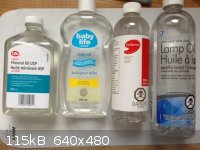
|
|
|
blogfast25
International Hazard
    
Posts: 10562
Registered: 3-2-2008
Location: Neverland
Member Is Offline
Mood: No Mood
|
|
EC1:
With regards to the oil, the tocopherols quoted I don't like so much.
Try a clean, clear lampoil, preferably 'deodorised' or 'low odour'. Check boiling point (range) before using, it should be 200 or slightly more. If
you want to be sure about water, dry with anhydrous soda or anhydrous MgSO4 (Epsom Salt). Mine came straight out of the bottle, though, the kind they
sell for garden path oil lamps and such like.
[Edited on 1-3-2013 by blogfast25]
[Edited on 1-3-2013 by blogfast25]
|
|
|
blogfast25
International Hazard
    
Posts: 10562
Registered: 3-2-2008
Location: Neverland
Member Is Offline
Mood: No Mood
|
|
With regards to the citronella, that was me: I found cirtonella scented kerosene (slighly yellow) and because the citronella is only a minimal
component I tried that kerosene. It worked but I didn't get any citronella scented potassium, just 'ordinary' K! 
[Edited on 1-3-2013 by blogfast25]
|
|
|
elementcollector1
International Hazard
    
Posts: 2684
Registered: 28-12-2011
Location: The Known Universe
Member Is Offline
Mood: Molten
|
|
Quote: Originally posted by blogfast25  | EC1:
With regards to the oil, the tocopherols quoted I don't like so much.
Try a clean, clear lampoil, preferably 'deodorised' or 'low odour'. Check boiling point (range) before using, it should be 200 or slightly more. If
you want to be sure about water, dry with anhydrous soda or anhydrous MgSO4 (Epsom Salt). Mine came straight out of the bottle, though, the kind they
sell for garden path oil lamps and such like.
[Edited on 1-3-2013 by blogfast25]
[Edited on 1-3-2013 by blogfast25] |
Guess I'll heat some Epsom salt to anhydrous, then. It goes to anhydrous around 200 C, so this is also a good test to see if my electric hot plate can
reach that.
Elements Collected:52/87
Latest Acquired: Cl
Next in Line: Nd
|
|
|
elementcollector1
International Hazard
    
Posts: 2684
Registered: 28-12-2011
Location: The Known Universe
Member Is Offline
Mood: Molten
|
|
Quote: Originally posted by blogfast25  | With regards to the citronella, that was me: I found cirtonella scented kerosene (slighly yellow) and because the citronella is only a minimal
component I tried that kerosene. It worked but I didn't get any citronella scented potassium, just 'ordinary' K! 
[Edited on 1-3-2013 by blogfast25] |
Aww. Now that would have made an interesting story for the kids one day.
Parents are extremely nervous about kerosene and a hotplate, so I'm going to stick with lamp oil for now.
EDIT: Found the lamp oil! It's unscented, and perfectly clear (so much for the lemon flavor).
[Edited on 2-3-2013 by elementcollector1]
Elements Collected:52/87
Latest Acquired: Cl
Next in Line: Nd
|
|
|
blogfast25
International Hazard
    
Posts: 10562
Registered: 3-2-2008
Location: Neverland
Member Is Offline
Mood: No Mood
|
|
Quote: Originally posted by elementcollector1  |
Parents are extremely nervous about kerosene and a hotplate, so I'm going to stick with lamp oil for now.
EDIT: Found the lamp oil! It's unscented, and perfectly clear (so much for the lemon flavor).
[Edited on 2-3-2013 by elementcollector1] |
Psst. Don't tell'm: lampoil is basically kerosene! Shhhh.... 
|
|
|
elementcollector1
International Hazard
    
Posts: 2684
Registered: 28-12-2011
Location: The Known Universe
Member Is Offline
Mood: Molten
|
|
Quote: Originally posted by blogfast25  | Quote: Originally posted by elementcollector1  |
Parents are extremely nervous about kerosene and a hotplate, so I'm going to stick with lamp oil for now.
EDIT: Found the lamp oil! It's unscented, and perfectly clear (so much for the lemon flavor).
[Edited on 2-3-2013 by elementcollector1] |
Psst. Don't tell'm: lampoil is basically kerosene! Shhhh.... 
|
I know... American education at its best. 
Elements Collected:52/87
Latest Acquired: Cl
Next in Line: Nd
|
|
|
elementcollector1
International Hazard
    
Posts: 2684
Registered: 28-12-2011
Location: The Known Universe
Member Is Offline
Mood: Molten
|
|
(Warning: this post is picture-intensive)
Well, another failure. Although something did end up happening, no K was formed. Total reaction time was roughly four hours, starting from 12:30 and
ending at about 4:15 (parents wanted to go on driving practice). Here are a bunch of pics:
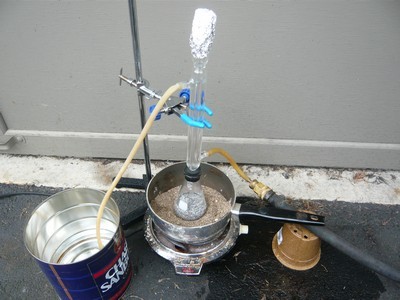
The general setup (the bucket was swapped out for a larger one, and aluminum foil was later added to conserve heat, but the general idea stays the
same).
Not pictured: The lamp oil was dried overnight with anhydrous MgSO4, with a cut balloon over the end of the flask to prevent too much air and water
entering. I came back morning, and the white powder certainly seemed a little 'fluffier' (though it could have been just my imagination).
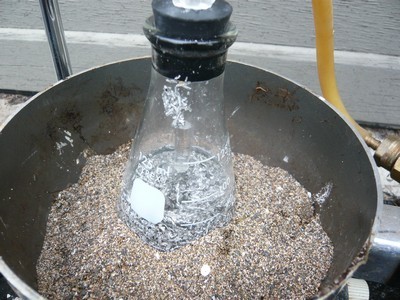
Ooh, shiny Mg turnings. These were drilled off a camping firestarter, and stored under oil for the night. The KOH is directly underneath, invisible
under all the bright metal.
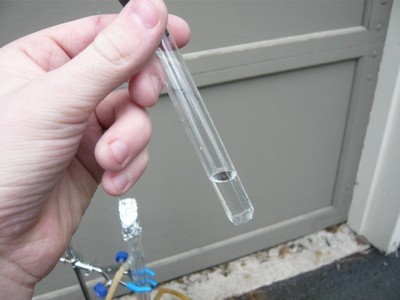
The catalyst mix: 1 mL t-BuOH / 2 mL lamp oil. Seemed to work perfectly, although there was always lots of bubbling whenever the catalyst was added. I
accidentally spilled the remaining catalyst about halfway through, so I made a new one with half of what was used before. This might introduce some
error, but then again, it is a catalyst.
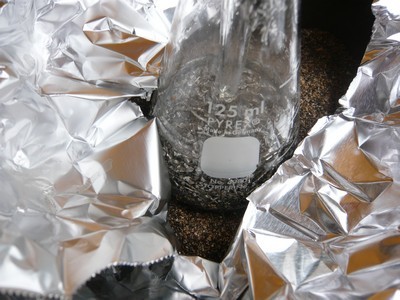
And things start to get a little darker.
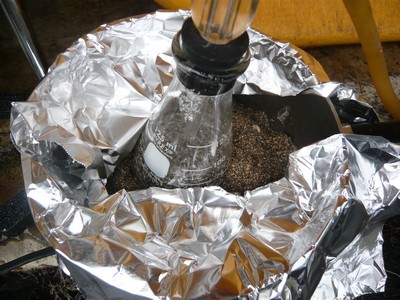
And darker.
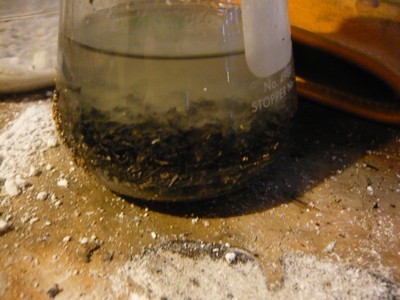
The end of the reaction. The KOH/K-t-BuO / MgO / whatever has formed a crust on the bottom, while the 'burnt' Mg resides on top. No potassium globules
were seen anywhere inside the flask, and the magnesium itself looks only half-reacted (not entirely consumed).
All in all, potential sources of error were:
-Magnesium metal may have been contaminated or otherwise rendered insufficient
-Solvent may have not worked (unlikely, as the t-BuOH dissolved fully).
-The catalyst may have somehow escaped the reaction (also unlikely, as reflux condenser was using outside water again.)Strangely, no frozen
tert-butanol was seen, indicating either the cooling wasn't sufficient (yeah, right) or the t-BuOH was refluxing perfectly.
Thoughts? I thought I saw a similar problem a few pages up.
TL;DR - Failure number three, moving on to plan for failure number four! 
[Edited on 3-3-2013 by elementcollector1]
Elements Collected:52/87
Latest Acquired: Cl
Next in Line: Nd
|
|
|
blogfast25
International Hazard
    
Posts: 10562
Registered: 3-2-2008
Location: Neverland
Member Is Offline
Mood: No Mood
|
|
What temperature was your cooling water this time?
You're sure the catalyst ended up and stayed in the flask?
|
|
|
Mailinmypocket
International Hazard
    
Posts: 1351
Registered: 12-5-2011
Member Is Offline
Mood: No Mood
|
|
All this talk of K has gotten me interested in trying again! Before that though, the last comments made by Pok further up thread are nagging in my
mind. He said that my Mg (which was purchased as "Mg turnings for Grignard reactions") seems to be very coarse, and that the lack of surface area may
be the cause of my failure. I have to admit that this Mg is coarser than most Grignard turnings I have seen...
Before deciding to try again, or call it a lost cause, what do you guys think of this Mg? I've attached an image with a ruler for scale. I'm inclined
to think that Pok was correct, but has anyone used a similar size Mg with success?
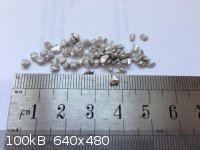
|
|
|
elementcollector1
International Hazard
    
Posts: 2684
Registered: 28-12-2011
Location: The Known Universe
Member Is Offline
Mood: Molten
|
|
It wasn't quite as frigid as the first time, but more than that I cannot say. The water flow was also a bit slower, so the water may have been 'warmed
up' more by the vapors.
Elements Collected:52/87
Latest Acquired: Cl
Next in Line: Nd
|
|
|
elementcollector1
International Hazard
    
Posts: 2684
Registered: 28-12-2011
Location: The Known Universe
Member Is Offline
Mood: Molten
|
|
Quote: Originally posted by Mailinmypocket  | All this talk of K has gotten me interested in trying again! Before that though, the last comments made by Pok further up thread are nagging in my
mind. He said that my Mg (which was purchased as "Mg turnings for Grignard reactions") seems to be very coarse, and that the lack of surface area may
be the cause of my failure. I have to admit that this Mg is coarser than most Grignard turnings I have seen...
Before deciding to try again, or call it a lost cause, what do you guys think of this Mg? I've attached an image with a ruler for scale. I'm inclined
to think that Pok was correct, but has anyone used a similar size Mg with success?
|
That does look pretty coarse. Are you sure you can't get some powder?
I used turnings in my last reaction, and they didn't work out so well, so I'd assume the more surface area the better.
Elements Collected:52/87
Latest Acquired: Cl
Next in Line: Nd
|
|
|
Mailinmypocket
International Hazard
    
Posts: 1351
Registered: 12-5-2011
Member Is Offline
Mood: No Mood
|
|
Quote: Originally posted by elementcollector1  | Quote: Originally posted by Mailinmypocket  | All this talk of K has gotten me interested in trying again! Before that though, the last comments made by Pok further up thread are nagging in my
mind. He said that my Mg (which was purchased as "Mg turnings for Grignard reactions") seems to be very coarse, and that the lack of surface area may
be the cause of my failure. I have to admit that this Mg is coarser than most Grignard turnings I have seen...
Before deciding to try again, or call it a lost cause, what do you guys think of this Mg? I've attached an image with a ruler for scale. I'm inclined
to think that Pok was correct, but has anyone used a similar size Mg with success?
|
That does look pretty coarse. Are you sure you can't get some powder?
I used turnings in my last reaction, and they didn't work out so well, so I'd assume the more surface area the better. |
The only other fine Mg I have is that intentionally oxide-coated shit that many experiments were done with previously. Sold to me as "fine magnesium"
but when I received it the MSDS claimed a percentage of added oxides for flame retardence 
I tried etching it with acid, didnt work. As you can see, it is quite fine, I'm sure it would work if it was not coated. I tried grinding it in a
mortar and pestle to expose fresh surfaces also- nothing. I can get powder, I just expected turnings to be more like turnings and not pea-shooter
sized bits of Mg.
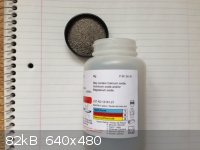 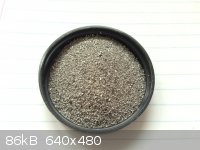
[Edited on 3-3-2013 by Mailinmypocket]
|
|
|
elementcollector1
International Hazard
    
Posts: 2684
Registered: 28-12-2011
Location: The Known Universe
Member Is Offline
Mood: Molten
|
|
...Put it in a coffee grinder?
Elements Collected:52/87
Latest Acquired: Cl
Next in Line: Nd
|
|
|
| Pages:
1
..
45
46
47
48
49
..
66 |